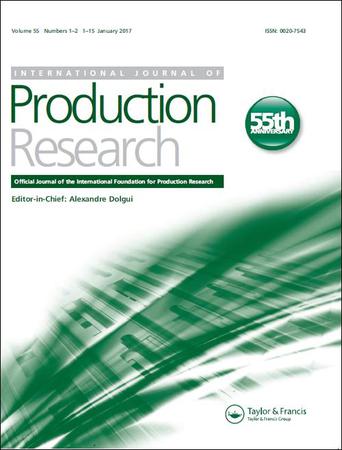Two-stage electricity production scheduling with energy storage and dynamic emission modelling
IF 7
2区 工程技术
Q1 ENGINEERING, INDUSTRIAL
International Journal of Production Research
Pub Date : 2023-11-09
DOI:10.1080/00207543.2023.2280186
引用次数: 0
Abstract
AbstractWith increasing environmental concerns and energy crisis, a variety of renewable energy sources (RES) are being increasingly utilised worldwide. However, the integration of RES such as wind power and photovoltaics in large-scale can lead to increased load fluctuations, which can undermine the overall environmental benefits and pose risks to the secure and stable operation of the power system. To mitigate this challenge, a two-stage electricity production scheduling is developed incorporating energy storage system (ESS) and dynamic emission modelling (DEM). In the first stage, a multi-objective mixed integer programming model schedules the production of RES, increasing penetration rate and system stability. In the second stage, a data-driven dynamic emission model is developed to optimise the load allocation of thermal power unit to reduce the carbon emissions. Furthermore, a flexible operating reserve strategy is proposed to handle the uncertainty resulting from the intermittent character of RES. Experimental results demonstrate that the proposed method effectively schedules the production of RES thereby alleviating the contradiction between high RES utilisation and stable system operation. Compared to the benchmark model, the proposed method can reduce the carbon emissions and total cost of the system by 20.34% and 10.65%, respectively.KEYWORDS: Renewable integrationenergy storage systemdynamic emissiongeneration scheduleoperational flexibility Disclosure statementNo potential conflict of interest was reported by the author(s).Data availability statementThe data presented in this study are available as request.Additional informationFundingThis research was supported by the National Natural Science Foundation of China [grant numbers 72174124, 71871146, 71701136], the Natural Science Foundation of Guangdong Province [grant numbers 2022A1515011009, 2021A1515010987], Shenzhen Science and Technology Program [grant number JCYJ20210324093414039], and by NTUT-SZU Joint Research Program [grant number 2023005].Notes on contributorsBi FanBi Fan, is an Associate Professor in the College of Management, Shenzhen University, Shenzhen, China. He received his Ph.D. degree in System Engineering and Engineering Management from City University of Hong Kong, in 2014. His research interests include the optimisation problems related to energy system management, intelligent manufacturing, and data-driven decisions.Fengjie LiaoFengjie Liao, is currently a postgraduate at College of Management, Shenzhen University, Shenzhen, China. He received the B.S degree from Shanghai Maritime University, Shanghai, China. His main research interests include power system dispatch and renewable energy planning.Chao YangChao Yang, is currently an Assistant Professor in Shenzhen University. He received the Ph.D. degree from Shenzhen University, Shenzhen, China, in 2020. His research interests include urbanisation, sustainable development, and the social-ecological effects of human activities.Quande QinQuande Qin, is a professor at the College of Management, Shenzhen University, located in Shenzhen, China. He obtained his Ph.D. degree in Management Science and Engineering from South China University of Technology in 2011. His research interests encompass a wide range of topics, including energy economics, environmental economics, energy technology management, energy system modelling, and energy policy. He has published in as Environmental & Resource Economics, Ecological Economics, Energy Economics, Energy Policy, Applied Energy, Renewable and Sustainable Energy Reviews, among others.基于储能和动态排放模型的两阶段电力生产调度
摘要随着人们对环境问题的日益关注和能源危机的加剧,各种可再生能源在世界范围内得到越来越多的利用。然而,风能、光伏等可再生能源的大规模整合会导致负荷波动增加,从而破坏整体环境效益,并对电力系统的安全稳定运行构成风险。为了缓解这一挑战,开发了一种结合储能系统(ESS)和动态排放建模(DEM)的两阶段电力生产调度。在第一阶段,采用多目标混合整数规划模型调度RES的生产,提高系统的渗透率和稳定性。第二阶段,建立数据驱动的动态排放模型,优化火电机组负荷分配,减少碳排放。实验结果表明,该方法有效地调度了可再生能源的生产,缓解了可再生能源的高利用率与系统稳定运行之间的矛盾。与基准模型相比,该方法可使系统碳排放量和总成本分别降低20.34%和10.65%。关键词:可再生能源集成储能系统动态排放发电计划运行灵活性披露声明作者未报告潜在利益冲突。数据可用性声明本研究中提供的数据可应要求提供。本研究得到了国家自然科学基金项目[资助号:72174124,71871146,71701136],广东省自然科学基金项目[资助号:2022A1515011009, 2021A1515010987],深圳市科技计划项目[资助号:JCYJ20210324093414039],深圳理工大学联合研究计划项目[资助号:2023005]的支持。作者简介毕凡,深圳大学管理学院副教授。他于2014年获得香港城市大学系统工程与工程管理博士学位。他的研究兴趣包括与能源系统管理、智能制造和数据驱动决策相关的优化问题。廖凤杰,现任中国深圳大学管理学院研究生。毕业于中国上海海事大学,获理学学士学位。主要研究方向为电力系统调度和可再生能源规划。杨超,现任深圳大学助理教授。2020年获深圳大学博士学位。他的研究兴趣包括城市化、可持续发展和人类活动的社会生态效应。秦全德,深圳大学管理学院教授。2011年获华南理工大学管理科学与工程专业博士学位。他的研究兴趣广泛,包括能源经济学、环境经济学、能源技术管理、能源系统建模和能源政策。曾在《环境与资源经济学》、《生态经济学》、《能源经济学》、《能源政策》、《应用能源》、《可再生能源与可持续能源评论》等刊物上发表文章。
本文章由计算机程序翻译,如有差异,请以英文原文为准。
求助全文
约1分钟内获得全文
求助全文
来源期刊

International Journal of Production Research
管理科学-工程:工业
CiteScore
19.20
自引率
14.10%
发文量
318
审稿时长
6.3 months
期刊介绍:
The International Journal of Production Research (IJPR), published since 1961, is a well-established, highly successful and leading journal reporting manufacturing, production and operations management research.
IJPR is published 24 times a year and includes papers on innovation management, design of products, manufacturing processes, production and logistics systems. Production economics, the essential behaviour of production resources and systems as well as the complex decision problems that arise in design, management and control of production and logistics systems are considered.
IJPR is a journal for researchers and professors in mechanical engineering, industrial and systems engineering, operations research and management science, and business. It is also an informative reference for industrial managers looking to improve the efficiency and effectiveness of their production systems.
 求助内容:
求助内容: 应助结果提醒方式:
应助结果提醒方式:


